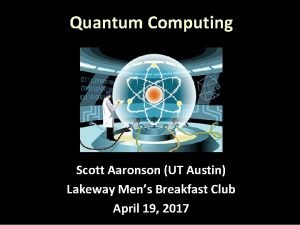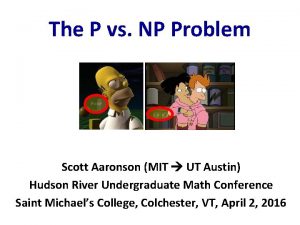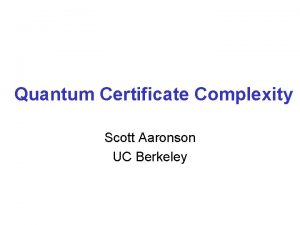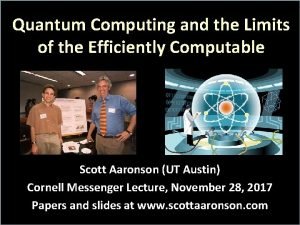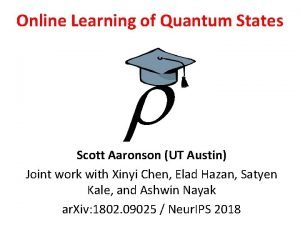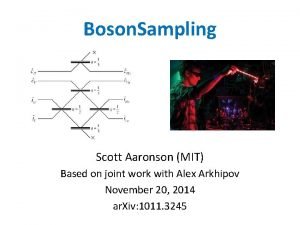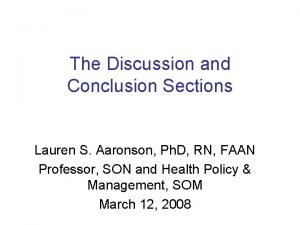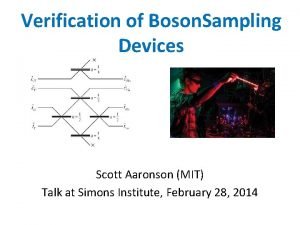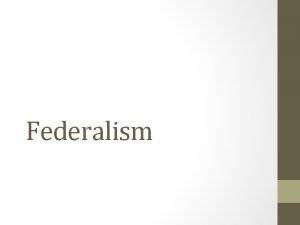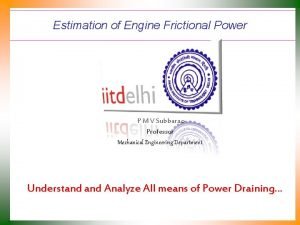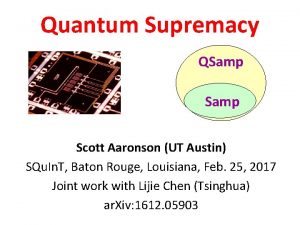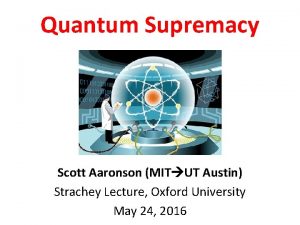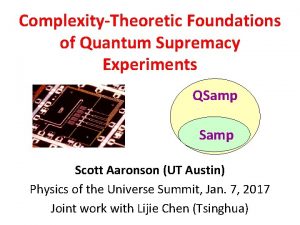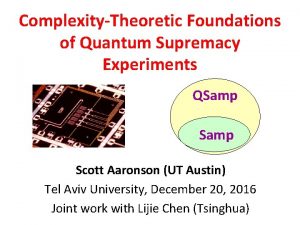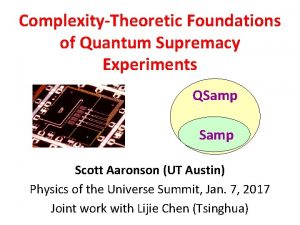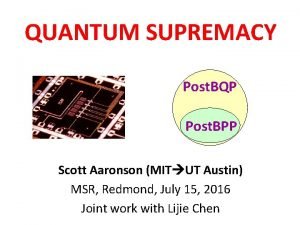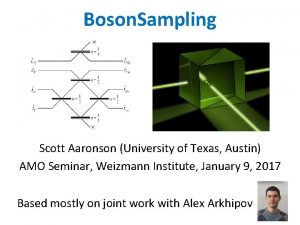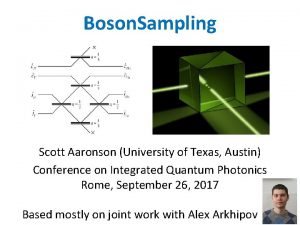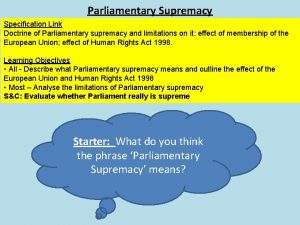Quantum Supremacy QSamp Scott Aaronson UT Austin Caltech














- Slides: 14

Quantum Supremacy QSamp Scott Aaronson (UT Austin) Caltech Physics Colloquium, February 9, 2017 Joint work with Lijie Chen (Tsinghua) ar. Xiv: 1612. 05903

QUANTUM SUPREMACY | #1 Application of QC: Disprove the QC skeptics (and the Extended Church-Turing Thesis)! Forget for now about applications. Just concentrate on certainty of a quantum speedup over the best classical algorithm for some task

The Sampling Approach Examples: Boson. Sampling (A. -Arkhipov 2011), Fourier. Sampling/IQP (Bremner-Jozsa-Shepherd 2011), QAOA (Farhi et al. ), … Consider problems where the goal is to sample from a desired distribution over n-bit strings Compared to problems with a single valid output (like FACTORING), sampling problems can be (1) Easier to solve with near-future quantum devices, and (2) Easier to argue are hard for classical computers! (We “merely” give up on: practical applications, fast classical way to verify the result)

Simple Example: Fourier Sampling |0 H H |0 H f can. H show that if the Using the #P-hardness, one quantum computer’s could |0 H output distribution H be exactly sampled in classical polynomial time, then P#P=BPPNP and hence the polynomial Given a Boolean function hierarchy would collapse to the third level the above circuit samples each z {0, 1}n with probability #P-hard to approximate, even for z=0… 0

Boson. Sampling (A. -Arkhipov 2011) A rudimentary type of quantum computing, involving only non-interacting photons Classical counterpart: Galton’s Board Replacing the balls by photons leads to famously counterintuitive phenomena, like the Hong-Ou-Mandel dip

With n identical photons, transition amplitudes are given by permanents of n n matrices Central Theorem of Boson. Sampling: Suppose one can sample a linear-optical device’s output distribution in classical polynomial time, even to 1/n. O(1) error in variation distance. Then one can also estimate the permanent of a matrix of i. i. d. N(0, 1) Gaussians in BPPNP Central Conjecture of Boson. Sampling: Gaussian permanent estimation is a #P-hard problem If so, then fast classical simulation would collapse PH

Carolan et al. 2015: Demonstrated Boson. Sampling with 6 photons! Many optics groups are thinking about the challenges of scaling up to 20 or 30… Meantime, though, in a few years, we might have 40 -50 high-quality qubits with controllable couplings, in superconducting and/or ion-trap architectures (Google, ion. Q, …) Still won’t be enough for most QC applications. But should suffice for a quantum supremacy experiment! What exactly should the experimenters do, how should they verify it, and what can be said about the hardness of simulating it classically?

The Random Quantum Circuit Proposal Generate a quantum circuit C on n qubits in a n n lattice, with d layers of random nearest-neighbor gates Apply C to |0 n and measure. Repeat T times, to obtain samples x 1, …, x. T from {0, 1}n Apply a statistical test to x 1, …, x. T : check whether at least 2/3 of them have more the median probability (takes classical exponential time, which is OK for n 40) Publish C. Challenge skeptics to generate samples passing the test in a reasonable amount of time

Our Strong Hardness Assumption There’s no polynomial-time classical algorithm A such that, given a uniformly-random quantum circuit C with n qubits and m>>n gates, Note: There is a polynomial-time classical algorithm that guesses with probability (just expand 0| n. C|0 n out as a sum of 4 m terms, then sample a few random ones)

Theorem: Assume SHA. Then given as input a random quantum circuit C, with n qubits and m>>n gates, there’s no polynomial-time classical algorithm that even passes our statistical test for C-sampling w. h. p. Proof Sketch: Given a circuit C, first “hide” which amplitude we care about by applying a random XOR-mask to the outputs, producing a C’ such that Now let A be a poly-time classical algorithm that passes the test for C’ with probability 0. 99. Suppose A outputs samples x 1, …, x. T. Then if xi =z for some i [T], guess that Otherwise, guess that with probability Violates SHA!

Time-Space Tradeoffs for Simulating Quantum Circuits Given a general quantum circuit with n qubits and m>>n two-qubit gates, how should we simulate it classically? “Schrödinger way”: “Feynman way”: Store whole wavefunction Sum over paths O(2 n) memory, O(m 2 n) time O(m+n) memory, O(4 m) time n=40, m=1000: Feasible but requires TB of RAM n=40, m=1000: Infeasible but requires little RAM Best of both worlds?

Theorem: Let C be a quantum circuit with n qubits and d layers of gates. Then we can compute each transition amplitude, x|C|y , in d. O(n) time and poly(n, d) memory C 1 C 2 Proof: Savitch’s Theorem! Recursively divide C into two chunks, C 1 and C 2, with d/2 layers each. Then Can do better for nearest-neighbor circuits, or when more memory is available This algorithm still doesn’t falsify the SHA! Why not?

Other Things We Showed Any strong quantum supremacy theorem (“fast approximate classical sampling of this experiment would collapse the polynomial hierarchy”)—of the sort we sought for Boson. Sampling—will require non-relativizing techniques (It doesn’t hold in black-box generality; there’s an oracle that makes it false) If one-way functions exist, then quantum supremacy is possible with efficiently computable (P/poly) oracles If you want to prove quantum supremacy possible relative to efficiently computable oracles, then you’ll need to show either that it’s possible in the unrelativized world, or that NP BQP

Summary In the near future, we might be able to perform random quantum circuit sampling with ~40 qubits Central question: how do we verify that something classically hard was done? Quantum computing theorists would be urgently called upon to think about this, even if there were nothing theoretically interesting to say. But there is!
 Ut austin quantum computing
Ut austin quantum computing Scott aaronson mit
Scott aaronson mit Scott aaronson p np
Scott aaronson p np Scott aaronson
Scott aaronson Quantum computing
Quantum computing Ut austin quantum computing
Ut austin quantum computing Boson sampling aaronson
Boson sampling aaronson Lauren aaronson
Lauren aaronson Boson sampling aaronson
Boson sampling aaronson Classical mechanics
Classical mechanics Quantum physics vs mechanics
Quantum physics vs mechanics A vassal owed his first loyalty to who
A vassal owed his first loyalty to who Petrine supremacy
Petrine supremacy Inherent powers examples
Inherent powers examples Black supremacy pmv
Black supremacy pmv
